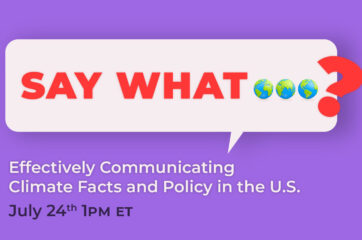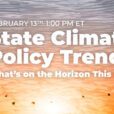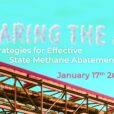As state legislative sessions begin around the country, staying up to date with the latest policy trends is essential for any climate actor. In this webinar, Climate XChange invited a group of experts to explore what climate policies are being introduced in state legislatures this year and what trends you should keep an eye on. Our panel included Ava Gallo, Climate & Energy Coordinator at the National Caucus of Environmental Legislators (NCEL); Sam Ricketts, Co-Founder and Senior Advisor at Evergreen Action, and Senior Fellow for Energy and Environment at the Center for American Progress; and Jordan Haedtler, former congressional aide and climate finance policy consultant working with The Sunrise Project.
In this recap article, we’ll provide highlights from our expert panel’s presentations and Q&A, including how federal funding can impact state climate policy, which states are this year’s most ambitious climate leaders, new climate-friendly trifectas after midterm elections, and state-level legislative trends including green banks, climate financing and ESG, and meeting and implementing statutory climate targets.
Ava Gallo, NCEL
Ava Gallo serves as the Climate and Energy Coordinator at the National Caucus of Environmental Legislators (NCEL), where she works to support legislators up and down the Eastern Seaboard and manages their transportation portfolio.
Implementation Year – How are States Meeting their Climate Goals?
In recent years, many states have set ambitious, legally-mandated climate goals and emissions reduction targets through legislation. These include New York’s Climate Leadership and Community Protection Act (2019), Washington State’s HB 2311 (2020), Vermont’s Global Warming Solutions Act (2020), Massachusetts’ Act Creating a Next-Generation Roadmap (2021), and Maryland’s Climate Solutions Now Act (2022). Now, these states are in the implementation phase. They are at varying stages of communicating to the public how they intend to achieve their goals, while also passing additional legislation to turn these targets into action.
In New York, they’re tackling the state’s number one emissions sector, buildings, with the All-Electric Building Act, introduced in the 2021-22 session and reintroduced this session. Washington State is working to provide municipalities with the funding and capacity to build resilience against increased natural disasters. Vermont, is looking to reduce emissions from the heating sector though a clean heat standard. A previous bill was passed, vetoed by the Governor, and almost overridden with a one-vote margin last year, and has now been reintroduced as the Affordable Heat Act. Massachusetts has introduced several bills (SD 1370/HD 2553, HD 1492) targeting the transportation sector, aiming to strengthen regional transit authorities and expand robust public transit beyond the Boston metropolitan area. Maryland has also introduced various pieces of legislation to meet their goals, including an attempt to electrify medium- and heavy-duty vehicles (MHDVs), which would match California’s standard.
New Opportunities for Climate Action
After this past election cycle, four states (Maryland, Massachusetts, Minnesota, and Michigan) have become new Democratic trifectas, meaning both chambers of the legislature and the governor’s office are controlled by Democrats. In the Midwest — MN and MI — this is particularly crucial, creating the opportunity to gain momentum on climate action in states that haven’t previously had climate-friendly majorities in state government.
In addition, the Bipartisan Infrastructure Law (BIL) and the Inflation Reduction Act (IRA) create a wealth of opportunities for climate action at the state level, especially as states are major players in implementing and distributing this funding. These federal initiatives have especially opened up opportunities for state progress on a few key climate areas. These include electric vehicles (EVs) and charging stations, as states are required to create EV plans to receive some of this funding; heat pumps, with a lot of money coming down for electrifying buildings; and utility reform and grid modernization, to build out transmission to the areas where renewable energy is needed the most. This federal funding creates new opportunities and incentives that all states can take advantage of, regardless of their past climate ambitions.
Sam Ricketts, Evergreen Action and the Center for American Progress
Sam Ricketts is a Co-Founder and Senior Advisor for Evergreen Action, and a Senior Fellow for Energy and Environment at the Center for American Progress. He focuses on advancing policies to achieve ambitious and equitable climate action and a 100 percent clean energy economy; the climate leadership of U.S. states; and building coalitions across environmental groups, progressive organizations, environmental justice communities, and labor unions.
Federal Climate Progress Follows State Leadership
The federal climate progress embodied in the BIL and IRA was built on state leadership, borrowing from various state trends in the last couple decades: the 100 percent clean electricity goal was already a commitment for 22 states; the the Greenhouse Gas Reduction Fund (GHGRF) was inspired by dozens of existing state and local green banks; the design of clean energy tax credits tied to labor standards is derivative of recently passed legislation in Washington and other states; and of course, the Justice40 Initiative and EJ investment requirements in the IRA come out of years of state leadership in equitable climate policy, including that of New York and California.
Federal Funding’s Impact on State Climate Policy
The IRA includes around $370 billion in projected investments over the next 10 years, but the final dollar amount could be higher, especially as more consumers and organizations take advantage of tax credits. The IRA combined with the BIL and CHIPs & Science Act amounts to around $500 billion in potential climate investment over the next decade.
For states, this means three big things. Firstly, it unlocks direct funding opportunities, where state agencies can use federal dollars for programs, policies, and plans of their own design. This includes $5b from DOT for National Electric Vehicle Infrastructure (NEVI), $9b from DOE on home energy efficiency and appliance electrification rebates, $27b from EPA for the Greenhouse Gas Reduction Fund (GHGRF) with $7b directly available for state and local programs, and $5b from EPA on Climate Pollution Reduction Grants, which is specifically designed to support state, local, and tribal governments and air pollution control agencies in executing on their visions for climate progress.
Secondly, it provides private sector incentives, financing, and partnerships that can be leveraged by state decisionmakers like state agencies, public utility commissions (PUCs), and economic development authorities to push their states even further on climate progress. Clean energy tax credits are available not only to consumers but also utilities and nonprofits; while this money doesn’t flow directly through states, it does empower PUCs and legislatures to embrace faster timelines on the clean energy transition. This also includes opportunities for states to leverage state purchasing with federal financing, such as through the DOE Loan Guarantee Program.
And lastly, federal formula grants provide states with increased discretion, giving them the responsibility to use federal money in new, innovative ways beyond the traditional infrastructure investment they’ve previously financed with these dollars. A notable example of this is DOT’s Surface Transportation Block Grant program, providing $70b over the next five years to move away from highway expansion and towards building more sustainable low-carbon transportation options.
States Leading on Climate Policy in 2023
There are many states utilizing this momentum to continue pushing forward on climate leadership this year. At the beginning of February, Minnesota became the 16th state to enact a 100 percent carbon-free power requirement through their newly enacted Clean Energy Standard. Multiple states are considering green banking legislation, the latest being New Mexico with SB 169, aiming to take advantage of the GHGRF by creating a state Climate Investment Center and Fund. Many states, including California, Colorado, and Minnesota, are moving to ensure they incorporate climate and low-carbon considerations in transportation planning. Building decarbonization is also a big focus this year, with California and Washington embracing appliance standards and building codes aimed at 100 percent zero-emission buildings, New York and Massachusetts pushing forward stretch codes, and Colorado and Vermont moving on clean heat standards.
Jordan Haedtler, The Sunrise Project
Jordan Haedtler is a former congressional aide who helped oversee the development of a climate risk supervision framework by federal banking agencies while serving on the staff for the U.S. House Financial Services Committee. Now, he is a consultant with The Sunrise Project, and is putting his blend of federal and state experience to work developing climate financial policies within the context of state government.
Anti-ESG State Policy: A Concerning Trend
Over the past few years, climate finance legislation has become a major realm of state-level climate action (or inaction). Under the Biden administration, federal climate financial regulation has begun taking shape, borne out of Treasury Secretary Janet Yellen’s identification of climate as an increasing threat to the country’s financial system. This has provoked an enormous backlash in states across the country, led by the fossil fuel industry. Organized through the State Financial Officers Foundation (SFOF) over the past two years, they have produced a robust effort against socially responsible financial investing known as environmental, social, and corporate governance (ESG).
Texas was the first state to successfully legislate against ESG as part of this push, when in 2021 they enacted the ALEC- and SFOF-drafted SB 13, prohibiting state governments from contracting or doing any business with financial institutions that are ‘boycotting’ fossil fuels. This targets major players like Blackrock, JPMorgan Chase, Wells Fargo, and others, and in 2021, Texas began canceling their relationships with these institutions, the first state to do so.
Following in Texas’s footsteps, six states passed similar bills in early 2022. In the summer of last year, Florida Gov. Ron DeSantis made a speech on ‘woke capitalism’, where he firmly denounced ESG and catalyzed a massive proliferation of these bills. Since the beginning of this year, over 100 anti-ESG bills have been introduced in 28 states.
Large coalitions are coming together to oppose this legislation, as the implementation of already enacted bills have proved to be disastrous, costing states millions of dollars.
Alternatives to Anti-ESG Legislation
Voters want to be shielded from the financial and economic risks of climate change, and they also want their state’s economy and pension fund to be integrated with the economic benefits of the clean energy transition — as such, the Sunrise Project has developed a slate of alternatives to anti-ESG legislation. Indirect alternatives include establishing green banks or utilizing a climate financial regulatory approach for insurance to protect consumers from soaring premium rates and other hazards being experienced in states with growing climate risk. A direct alternative to anti-ESG policy is proposing legislation that applies a climate risk assessment to the state’s investment portfolio or pension fund, as Maryland has done and as Colorado, Washington, and Massachusetts are also attempting to move on.
If your state has introduced an anti-ESG bill, contact The Sunrise Project for model legislation or general policy support.
Q&A
Q: What are examples of best practices to follow for effective state-level implementation of federal climate dollars?
Ava Gallo: Other than green banks, which we’ve already talked about at length, I can provide some high-level thoughts. A lot of the funding is going to go through state agencies, so some legislators think they can’t really interact with that funding, but there’s a lot of ways that they can. State legislators can add to the mandates of their state agencies that can help direct the funding to where they need to go for the state’s emissions reduction goals. For example, oftentimes I will see that state legislators have some tension with state DOTs, which are focused on some old-school policies like widening highways, which we know doesn’t work. There is a lot of leeway, particularly with the BIL, wherein the guidelines are broad and money can be funneled to those projects like rebuilding roads, instead of thinking about policies like complete streets, or advancing public transportation. In Colorado, they required their state to consider GHG emissions from all the projects they propose. I have a lot of examples of states requiring utilities to think about climate and equity goals in their mandates. So, unless agencies have that authorization or requirements from state legislators, they won’t normally tend to act on it, so that’s a big way they can have an impact. It’s still early this year to see how states are moving on this, but Maryland passed legislation last year that required efforts to pursue federal funding for transmission upgrades for their renewable energy goals.
Sam Ricketts: I think Ava summarized that perfectly. Another thing is that it can be overwhelming, and there are certainly capacity gaps in state and local governments, tribal nations, and community organizations who are newly elevated for billions in funding. Attending to that capacity is key, making sure that these agencies are well-resourced to be able to do this work. Now, there’s a couple different ways of looking at all this new federal funding — rather than thinking of it as a massive football that needs to be caught, you can go back to your state’s own priorities. Rather than thinking of how you have to use the IRA, think about your state’s priorities on building decarbonization, for example, and how you can use DOE programs to advance that. How can you make sure people know about the EV tax credits, so you can advance our state goals? Just today, you see Governor Phil Murphy accelerating his state’s commitment to clean electricity by 15 years, in part due to new federal investments and resources, and Governor Janet Mills in Maine doing something similar. Whatever states are already committed to moving on, federal funding provides a tailwind or lubricant to do that.
Jordan Haedtler: In addition to what Sam just mentioned, the federal government is just now starting to send signals to the state of how they want to see the IRA implemented. They are looking for detailed plans, including the integration of labor standards, assistance to disadvantaged communities, compliance with Justice40 — we just got EPA guidance yesterday on the GHGRF, highlighting rooftop installations, which wasn’t something we were expecting. If I were to guess what’s behind that, it’s that they’re looking to prioritize investments with a very tangible consumer benefit. So, sending signals — writing legislation or sending letters — that indicates to the Biden administration that you’re aware of these resources and you know exactly how you plan to prioritize funding is really important. The administration is going to look at that and say, oh yes, we’ll go to this public entity because they have a really smart plan in place.
Q: What are some key types of partnerships required for effectively implementing federal funding at the state level?
SR: There’s a specific example just from today on EPA’s webinar on Climate Pollution Reduction Grants. The program provides $5 billion in planning and implementation grants to states, air pollution control agencies, tribal nations, and local governments to design their own plans and execute on them. Part of that is just the encouragement of collaboration. For the dollars that go to the state, they still want the state to work with the tribes, local governments, and community organizations. There are new resources that actually flow directly to community-based organizations, like the EJ Block Grant program, which is not eligible for states; community-based organizations can work with local governments, or academia, in a way that will be fruitful. They also want states and local governments to work across jurisdictions with each other. With the targeted investments in disadvantaged communities, based on tried and true state examples, there are new forms of partnerships unlocking collaboration with state agencies, community-based organizations, and federal government, and that’s really exciting.
AG: I really want to drum home those green banks, which seems to be the main takeaway from this whole conversation. Just to pull up a statistic, a lot of people think of state-level green banks as government-funded, but green banks have spent $2.6 billion to create $9 billion in total investment. So, often, these green banks leverage a lot of private funding, even more than the funding that goes through on the government level. That’s really important to centralize the state’s opportunities to work and collaborate together.
Q: What suggestions do you have for states without a climate majority in their government?
JH: We’ve had a lot of success and are working to do more on organizing people at the municipal level. For instance, with this anti-ESG push, there was a tiny school district that had to cancel its bond deal with UBS, a big bank, entirely because of this arbitrary determination that UBS could no longer participate in Texas’s municipal bond market. That’s an opportunity to engage a more rural school district, a more rural bond market, in a state that’s not necessarily as friendly to good climate policy. I see a lot of opportunities to work with this sort of strange bedfellow coalition to raise the alarm bell about the costs that these measures are imposing, and opportunities being missed because of the state’s movement in that direction. Also, organizing around utilities, even if you’re not necessarily in the most hospitable environment, there’s a lot of bipartisan work going on around PUCs in state legislatures, in making sure that ratepayer money is not going toward lobbying against clean energy.
AG: We put together a Southern Climate Solutions Briefing Book for exactly this reason. We have legislators that are super excited about the progress in California and New York and Washington State, but they want to know what other states in different political contexts, like in the South, are doing, so they don’t have to reinvent the wheel. This Briefing Book looks at what has been successful, with bipartisan support, so you don’t need to come up with opportunities from scratch. And just like Jordan was saying, utilities and grid work is an area that has not yet become so politicized as some other climate topics, and it centers around a lot fo conservative talking points, like getting rid of monopoly utilities and providing the least cost option. Utility policy is climate policy.
Conclusion & Key Takeaways
With a wealth of federal climate funding coming to states from the IRA and BIL, and a targeted focus on equity through Justice40, states are primed to move aggressively on climate policy this year, with much of the available federal funding handing states increased discretion on how the dollars are spent. In many states, this is also a year to begin executing on their ambitious climate targets. Pertinent state policy trends to watch include green banking legislation, building decarbonization, and anti-ESG bills.
Regardless of how your state is dealing with implementing federal climate dollars, moving (or not moving) on ambitious climate goals, or tackling anti-climate legislation, you can look to other states to learn best practices. Further, for state decisionmakers, working across jurisdictions and sectors with local governments, NGOs, and other agencies is crucial for effective implementation of climate funding and policy. Staying connected and collaborating with each other is key to moving toward a clean energy economy in a swift and equitable manner.








